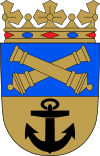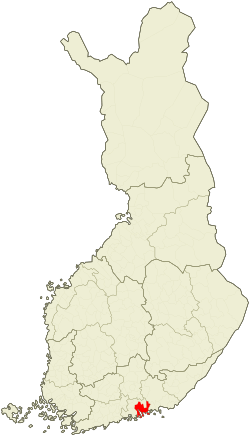Loviisa
Loviisa (Finnish pronunciation: [ˈloʋiːsɑ]; Swedish: Lovisa [luˈvǐːsɑ] (![]()
Loviisa Loviisa – Lovisa | |
|---|---|
Town | |
| Loviisan kaupunki Lovisa stad | |
 Coat of arms | |
 Location of Loviisa in Finland | |
| Coordinates: 60°27.5′N 026°14′E | |
| Country | |
| Region | Uusimaa |
| Sub-region | Loviisa sub-region |
| Charter | 1745 |
| Government | |
| • Town manager | Jan D. Oker-Blom |
| Area (2018-01-01)[1] | |
| • Total | 1,751.52 km2 (676.27 sq mi) |
| • Land | 819.57 km2 (316.44 sq mi) |
| • Water | 931.92 km2 (359.82 sq mi) |
| Area rank | 95th largest in Finland |
| Population (2019-01-31)[2] | |
| • Total | 14,873 |
| • Rank | 76th largest in Finland |
| • Density | 18.15/km2 (47.0/sq mi) |
| Population by native language | |
| • Finnish | 59.2% (official) |
| • Swedish | 38% |
| • Others | 2.8% |
| Population by age | |
| • 0 to 14 | 14.2% |
| • 15 to 64 | 63% |
| • 65 or older | 22.8% |
| Time zone | UTC+02:00 (EET) |
| • Summer (DST) | UTC+03:00 (EEST) |
| Postal code | 07900 |
| Area code(s) | 019 |
| Municipal tax rate[5] | 19.75% |
| Climate | Dfb |
| Website | www.loviisa.fi |
The municipality covers an area of 1,751.52 square kilometres (676.27 sq mi) of which 931.92 km2 (359.82 sq mi) is water.[1] The population density is 18.15 inhabitants per square kilometre (47.0/sq mi).
The neighboring municipalities of Liljendal, Pernå and Ruotsinpyhtää were consolidated with Loviisa on 1 January 2010.
Loviisa was founded in 1745, as a border fortress against Russia. Most of the fortifications have been preserved. Loviisa was originally called Degerby, but king Adolf Frederick of Sweden renamed the city after his spouse Lovisa Ulrika after visiting the town in 1752.
Loviisa is the site of two of Finland's nuclear reactors, two VVER units each of 488 MWe, at the Loviisa Nuclear Power Plant. The other operating reactors are at the Olkiluoto Nuclear Power Plant.
 The Church of Loviisa
The Church of Loviisa The harbor of Loviisa in 1808 by Gavril Sergeyev
The harbor of Loviisa in 1808 by Gavril Sergeyev Loviisa Fortress
Loviisa Fortress
Politics
Loviisa is led by a town council with 35 members. The Swedish People's Party gained majority in the municipal election in 2017.
- Swedish People's Party 18 seats
- Social Democratic Party 8 seats
- National Coalition Party 3 seats
- Non-aligned (former True Finns) 2 seats
- Green League 2 seats
- Centre Party 2 seats
International relations
Twin towns — sister cities
Loviisa is twinned with:
History and sights
The building of the sea fortress of Svartholm, located to the south from the city, was begun at the same time as the fortification of Loviisa. The purpose of the sea fortress was to protect the city from the sea, as well as to offer safe haven for the Swedish coastal navy. A joint Anglo-French navy unit destroyed the battlements of the island during the Crimean War. No longer fit for use the fortress was left to decay. As of the 1960s the fortress has been restored led by the National Board of Antiquities. The restoration was brought to a conclusion in time for the 250th jubilee of the fortress in 1998.
During the summers various programmes are arranged on the island for both locals and tourists. The guided tours, an exciting adventure for juniors and a restaurant lure both boaters and people travelling by the ferry boat, which does regular traffic between Loviisa centre and Svartholm.
Loviisa is also renowned for its Old Town. The Old Town was spared from the great fire of 1855. An annex of the Degerby estate, dating from the 17th century, is located in the Old Town. The building is one of the oldest surviving wooden houses in Finland. In Loviisa there is also a high society clubhouse, the only one of its kind in Finland spared from fires. Having been restored it now is a library/mediatheque. The first church in Loviisa was destroyed during the fire. The current Neo-Gothic church was inaugurated in 1865.
The German Brandenstein division landed in Valko in Loviisa on April 7, 1918. The division advanced as far as to Lahti, before returning to Loviisa in order to leave the country on December 16, 1918, as Germany had lost World War I.
The summers are lively in Loviisa. The most popular summer events are the Historical Houses of Loviisa (an event for traditional house building and renovating), the Sibelius Days, the Loviisa Day on August 25 and the King Arrives in Loviisa (a weekend in the spirit of the 18th century), Small Ships' Race (festival for traditional small sailing ships), the Peace Forum and the horse trotting contests
Industry
Loviisa boasts many companies useful for the local tourism. The harbour in Valko and the Loviisa Power Plant bring industry to Loviisa. There is also an industrial park in the Uusikaupunki district, housing many smaller companies, for instance mechanical shops and retail sellers of spare parts.
There is a harbour for cargoes such as timber, bulk and parcelled goods in the southern city district of Valko. From the harbour there is a traffic connection to Route 7, the major highway between Helsinki and St Petersburg. Loviisa centre is located immediately by Route 7, equally close to Helsinki and the Russian border. There is also a train connection from the harbour to Lahti, from where the carriages can reach other destinations in the country. The route into the harbour is 9.5 meters deep.
Notable people
- Jaana Toivari-Viitala - egyptologist
References
- "Area of Finnish Municipalities 1.1.2018" (PDF). National Land Survey of Finland. Retrieved 30 January 2018.
- "Suomen virallinen tilasto (SVT): Väestön ennakkotilasto [verkkojulkaisu]. Tammikuu 2019" (in Finnish). Statistics Finland. Retrieved 15 March 2019.
- "Population according to language and the number of foreigners and land area km2 by area as of 31 December 2008". Statistics Finland's PX-Web databases. Statistics Finland. Retrieved 29 March 2009.
- "Population according to age and gender by area as of 31 December 2008". Statistics Finland's PX-Web databases. Statistics Finland. Retrieved 28 April 2009.
- "List of municipal and parish tax rates in 2011". Tax Administration of Finland. 29 November 2010. Retrieved 13 March 2011.
- http://kaino.kotus.fi/svenskaortnamn/?a=find&qfind=Lovisa
